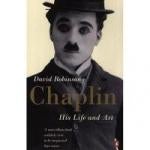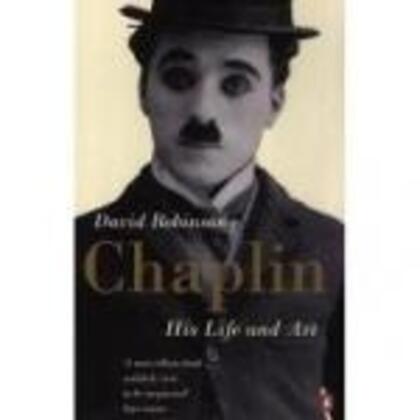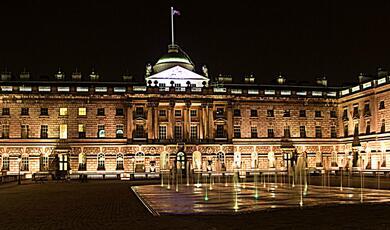Charles Chaplin: Bridging Three Centuries
Share
- Details
- Text
- Audio
- Downloads
- Extra Reading
This lecture explores the phenomenon of Chaplin's mythical status not only in film, but in world cultural history. It traces the creation of the myth to Chaplin's British origins; as a child of the poorest streets of Victorian London and as an alumnus of the British music hall at its zenith.
Download Text
Charles Chaplin: Bridging Three Centuries
David Robinson
13 January 2011
My name is Rick Senat – I am the Chairman of the London Film Museum – and I would like to welcome all of you today. You are very welcome to be here, we are very pleased to see you, and thank you for coming. I would like to thank colleagues at Gresham who have put this together and in particular Professor Michael Mainelli who suggested this today. We are very grateful and very pleased to see you all.
It gives me great pleasure today to introduce David Robinson, who is going to talk today about Charles Chaplin. David Robinson is recognised around the world as one of the foremost, perhaps the foremost, Chaplin authorities. He is a scholar and an authority, and his biography of Chaplin, “Chaplin: his Life and Art”, remains the standard authority on this great artist. The book was recently cited by the Wall Street Journal as one of the very best cinema biographies of all times. David was a film critic of the Financial Times for many years and then the Times for many years, and I am certain that many of you have read some of his work. He is the author of many books on cinema history, and he is currently the Director of the Giornate Del Cinema Muto which is the Silent Film Festival in Pordenone, an absolutely magnificent festival that takes place once a year in October, near to Venice. He is a member of our Museum’s Advisory Committee and it is his outstanding contribution to the curation of the exhibition that we have in the Museum today entitled “Chapman: the Great Londoner” that brought us all here today.
So, thank you, Gresham, again, for sponsoring this lecture today, the first of many, I hope, and here, ladies and gentleman, is David Robinson.
David Robinson
I have called this talk “Bridging Three Centuries”, and my hope is to explore the idea that the unique quality of Chaplin’s art was not only his ability to use comedy to probe the secrets of the human heart and psyche, but his special sense of how the greater movements of human history affect individual destinies. We are now in the second decade of the 21st Century, but Charlie Chaplin is, in spirit and in artistic creation at least, alive and well. Never have his films been more readily available, with everything he ever made now on DVD, in beautifully restored editions. Practically every week, there are performances of his silent films, with live orchestra, somewhere in the world. In two weeks, Charlie Chaplin’s Circus is being shown in Bristol, with an orchestra, and three weeks after that, in Lambersart near Lille. There are Chaplin seminars and Chaplin conferences across the world. Six or seven weeks ago, I was at a huge Chaplin conference in Zanesville, a lost place in America.
So, Chaplin still holds a firm place in the 21st Century, and yet, he was born 122 years ago, in the 19th Century. He remembered the soldiers going to the Boer War, and he was working, as a child, before that century ended. Thus this one man’s creative influence spans three centuries: the 19th, the 20th and now the 21st. Though he was born very near the end of the 19th Century, the world which he knew as a child retained much from earlier times. Very often, we say that Chaplin’s early life, his childhood, the London he knew, was truly Dickensian, and it was no accident that, in his adult life, his favourite author was Charles Dickens and his favourite book was Oliver Twist.
Chaplin was born in 1889 to a couple, both of whom were singers in the music halls. When they married, his mother already had an illegitimate son, Sidney, who was to be a strong influence on Charles Chaplin throughout his career. His father was a minor star of the music halls – he was good enough for the song publishers to put his picture on the front of their music. Those are two songs sung by the elder Charles Chaplin. His mother was less successful as a singer, although Chaplin, in his memories, regarded her as a very talented artist, from whom he had learnt a great deal.
His father was successful enough to embark, in 1891, on a tour of American vaudeville, but in his absence, Mrs Chaplin embarked on an affair with another music hall artist, Leo Dryden, who was a rather bigger star than Mr Chaplin. This resulted in a pregnancy and her separation from Mr Chaplin, and, from that time, things began to deteriorate. Chaplin’s absentee father declined into alcoholism and rarely paid the money for his children’s upkeep. He died at the age of 37.
Mrs Chaplin struggled to keep herself and her two sons by sewing shirts, but the little family often lived in acute poverty, moving from one wretched room to another. This is one house in which they lived in Kennington.
Often having little to eat and no money for clothes, Mrs Chaplin’s mental health deteriorated and, in time, she spent more and more of her life in mental hospitals. Finally, the boys, Chaplin, aged 7 and Sidney, 11, were put into homes for destitute children. This is the home at Hanwell, where Chaplin spent most of his seventh year.
This lonely and loveless time was agonising to the child. That is Jackie Cougan in “The Kid”, 1921, a film he made years later, in which he was to recall the horror of being snatched away from the people you love. .
As it is described in his autobiography, this was a period of privation such as is hard for us today to imagine, and all that Chaplin tells us is factually confirmed by the public records, which used to be kept in the basements here although they have now moved. The public records document the movement of the little family as dependents on public institutions, like this grim workhouse in Lambeth in London, which was familiar with the little family. It is worth saying that that workhouse is currently a very extensive private film museum, which seems a very apt use for this old building.
Then, at the age of 10, young Charlie Chaplin’s life changed. He went to work. He discovered his vocation. Remember that this was still in the last years of the 19th Century. From his parents, he had inherited skills in performing, and through his father’s influence, he found a job in a little troupe of child performers called “The Eight Lancashire Lads”.
There he is, smartened up, with his Eton collar, as a member of “The Eight Lancashire Lads”, who sang and clog-danced.
For almost two years, he toured with the troupe, and it was a great education, both in art and in life. The music hall was a fine training in stage technique. These were the great days of this unique style of popular theatre. It was the universal popular entertainment, and its most successful artists were the equivalent of popstars today, although generally they were rather better behaved. The music halls were often huge and their audiences very aggressive and demanding. Artists, even a 10 year old boy in a tap dance troupe, had to develop the skills of capturing and holding the attention and the liking of an audience for the few minutes when they were on the stage.
“The Eight Lancashire Lads” were a successful act and visited some of the best theatres in Britain. One of Charlie’s last engagements with them was at the newest and most spectacular theatre in London, the Hippodrome, where he played the part of a comic cat in the pantomime of Cinderella. He got into some disgrace when he was doing that because he made the cat do rather dog-like things with its back leg.
As an education in life also, the business of travelling every week from one town to another; staying in lodging houses of various states of hospitality and cleanliness; and working with other professionals must have been challenging for a 10 year old boy.
This job took him from the 19th into the 20th Century. There was a year or two without work but, from the age of 14, he was constantly employed in the theatre. For three years, he toured in legitimate dramatic theatres, always playing the role of Billy, a comic pageboy, in “Sherlock Holmes”. After this, he worked as a comedian in sketch companies, in repairs, where he played the incompetent plumber’s mate, or the plumber’s incompetent mate, in Case’s Court Circus, and we can see that he was already the star of the troupe. It was a juvenile troupe - they were boys - but he was obviously the star because he sits beside the proprietor of the troupe there, wearing a bowler hat.
However, most importantly, he joined Fred Karno’s touring sketch companies. This is Karno, who was one of the great comedy impresarios of the music halls in the early years of the century. With Karno, he became a star comedian on both sides of the Atlantic.
Here he is, in America, posing alongside posters which show that already, long before he even thought of the films, he was a star.
It was because of the reputation that he had acquired on the stage that he was recruited in 1914 to the cinema to star in the productions of Mack Sennett’s Keystone comedies. I have dwelt a little on these experiences of Chaplin’s first 25 years, the poverty-stricken boyhood and the precocious professional career, because, for me, it explains, as much as anything can explain, the secret of Chaplin’s genius.
To summarise, the first 10 years were spent in circumstances which would have killed most normal children, witnessing poverty, hunger, a broken family, drunkenness, madness and life on the streets and in public institutions. Chaplin was submitted to more concentrated and more acute human experience than most ordinary people can encounter in an entire lifetime, and this strange, serious, sensitive little boy did not succumb, but absorbed into his memory and soul everything that happened in those first 10 years.
The next 15 years was spent in learning an expressive art, the art of acting, and particularly pantomime. Chaplin, in a unique way, put these two things together; the human experience and the artistic expressiveness, and I believe that, if it is in any way possible to explain his art, it is this combination of human understanding and artistic expressiveness that explains his unique ability to convey, in a look or a gesture, great depths of human feeling. He could express the most fundamental manifestations of the heart and soul in a way that has made his art universal. In his external characteristics, the Little Tramp, the character by which Chaplin is best known, comes directly from the London streets of the 19th Century, but his feelings are simply human and understood everywhere and by everyone – in China, New Zealand, Mongolia or India. I would say that there has never been so universal an artist, in any field.
Chaplin remained, to the end of his days, acutely sensitive to the human condition at large, not just the intimate sentiments and emotions. With time, he became much more vitally concerned with the greater issues of the day. As time goes on, Chaplin’s Little Tramp begins to offer an incidental commentary on the changing world of the 20th Century. It was not a characteristic always appreciated by his critics. Many people writing about modern times or the great dictator complained that Chaplin was getting above his station and was dealing with issues that were not the business of a mere clown. However, Chaplin rightly believed that comedy is a medium as serious as any other, and that the comedian has a duty – not just a right – to hold his distorting mirror up to nature in all its forms.
The universe of Chaplin’s first films is generally carefree, concerned just with flirtations in the park or struggles to make a living, preferably by stealing, but after only four months in the studio, Chaplin took over direction of his own films, and he was to remain, to the end of his career, his own director. Indeed. He was also his own writer, his own star and when the music acquired sound, his own composer. Chaplin was a man of all parts. With his films, he did everything.
From this time of independence, there were increasing references to wider issues. In one of his earliest self-directed films, when he was still at the Keystone studios in 1914, “Dough and Dynamite”, there are strikers, labour dissent and bomb plots, issues that were to become even more real and urgent in the days after the First World War. In “Police”, he depicts the harder reality of vagrant life.
When he began to acquire the financial and creative independence that he sought, we found him more endeavouring to explore the social realities of the 20th Century.
A famous early film was “Easy Street”. There is Chaplin in “Easy Street”.
This undoubtedly recalls the poor streets of Chaplin’s London, all within a mile of this building, with their crime, bullying, drink and drugs. If anyone doubts that Chaplin was recalling real experience in these films, it is worth mentioning that, while Chaplin called his film “Easy Street”, he had known this real-life street, close to here, which was called Hard Street.
Here is another street which Chaplin knew as a boy - Henry Place, Lambeth - which makes a very interesting comparison.
In “The Immigrant”, he looks with wry comedy at the hardships endured by the vast hoards of immigrants leaving Europe for the promise of the American Dream. He introduced a ferociously ironic comment, which shocked his collaborators and offended many critics of the time. The immigrant ship arrives – there is a shot of the Statue of Liberty and the title “Arrival in the Land of Liberty” - and at that moment, the immigration officers roughly throw a rope around the new arrivals as if they were cattle.
In 1918, Chaplin opened his own studio. The First World War was still raging, and Chaplin’s second film in his new studio was to be “Shoulder Arms”, one of the most enduring works of art to come out of the war. At the time, many people were shocked that Chaplin should treat the war as a subject for comedy, but the mud, the rats, the vermin, the bad food, the flooded trenches, the ruined houses were nonetheless real and awful for being turned into gags.
The title before that is “Poor France – a ruined home”.
Here are Chaplin and his brother. They are in the trench and, later in the film, that trench becomes flooded. It is quite interesting just technically to see how it was done because the trench was actually built in the swimming pool at the studio so they just filled up the swimming pool and the dugout flooded.
There was another film involving letters from home, in which Chaplin miraculously distilled the whole poignancy of loneliness.
Better than any other clown in history, Chaplin was able to prove that comedy is never as rich as when it is poised on the edge of tragedy. He metamorphosed the real-life horrors of war into a cause for laughter, and in the event, there was no audience more appreciative of “Shoulder Arms” than the men who had seen and suffered the reality.
In “The Kid”, as we have mentioned, he drew upon the experiences of his own childhood. As the kid, Jackie Cougan is, in many ways, the alter ego of that infant Chaplin, who struggled to earn a penny on the streets of Victorian England. Through him, Chaplin looked at the effect of deprivation and the threat of incarceration in public institutions as a child.
Chaplin’s most critical look at the 20th Century came with “Modern Times”. After the release of “City Lights” in 1931, he had taken time off for a prolonged world tour. By this time, he was a world celebrity and was sought out by politicians, philosophers, royalty and people such as Winston Churchill and Albert Einstein. He became very close to the great men and the great issues of the day. He became more and more troubled by the world economic crisis. He read a lot about it and even composed his own economic solution to the situation, which was very intelligent. Politically very percipient, he saw the mounting perils of 1930s Europe far more clearly than many politicians seem to have done.
During his world tour, in 1931 to 1932, he actually got into trouble by telling a reporter: “Patriotism is the greatest insanity the world has ever suffered.” By “patriotism” of course, he meant fascism. “I have been all over Europe in the past few months. Patriotism is rampant everywhere and the result is going to be another war. I hope they send the old men to the front the next time, for it is the old men who are the real criminals in Europe today.” That was in 1930 and 1931.
More than 30 years afterwards, Chaplin found no reason to modify his views. “How can one tolerate patriotism” – read fascism – “How can one tolerate patriotism when six million Jews were murdered in its name?” Prescient as his opinion was, however, it was far from fashionable in the England of 1931, and he was widely criticised for expressing such opinions.
Much of what he had absorbed in his tours was reflected in “Modern Times”. Here, through his usual lens of comedy, Chaplin looked at the dehumanising and economic effects of automated factory life. He also dealt with labour unrest - the heroine’s father is killed by police, shooting at strikers; with political intolerance – the tramp is imprisoned when he is believed to be leading a Communist demonstration, which he is not; with drugs; with many of the situations that still concern us today.
Later in the Thirties, he was no less disturbed by events in Spain, although his feelings were not expressed on film but through literature. In April 1938, the French film magazine “Cinemonde” published a translation of a remarkable short story by Chaplin himself, entitled “Rhythm”. It describes the execution of a Spanish loyalist, a popular humorist writer. The officer in charge of the firing squad was formerly a friend of the condemned man - quoting Chaplin: “Their divergent views were then friendly, but they had finally provoked the unhappiness and disruption of the whole of Spain.” The officer and the six men of the firing squad all privately hope that a reprieve may still come. Finally though, the officer must give the rhythmic orders: “Attention, shoulder arms, present arms, and fire!” The officer gives the first three orders. Hurried footsteps are heard. All realise that it is the reprieve. The officer calls out “Stop!” to his firing squad, but six men each held a gun, six men had been trained through rhythm, six men hearing the shout “Stop” fired. The story at once embodies those fears of seeing men turned into machines, which Chaplin had expressed in “Modern Times”, and looks forward to some grim, ironic gags in “The Great Dictator”, his next film.
There is more evidence of Chaplin’s feelings about Spain in a poem, “To a Dead Loyalist Soldier”, which he scribbled in a folio notebook amongst memoranda, presumably in the winter of 1936 to 1937. The poem was quite clearly never meant for publication or even for other eyes. It was a private attempt to express his sentiments. Chaplin never changed his views, and though his daughter Geraldine had made her home, for many years, in Spain, Chaplin refused absolutely to visit her or set foot in Spain as long as General Franco was alive. The General in fact predeceased Chaplin by two years, but, by that time, Chaplin was no longer strong enough to travel, so, sadly, Spain was one of the few European countries he never visited. There was, he said, euphemistically, in the late 1930s, “a good deal of bad behaviour in the world”. Feeling as deeply as he did, he felt impelled to do whatever he could to correct it, or at least to focus attention on it, hence “The Great Dictator”.
It was somehow inevitable that he would play the role of Hitler. These two men were born within four days of each other, in the same year, in 1889. They were the same height, and both wore the same moustache, though only one of them was real. It was often even suggested that Hitler had adopted the moustache to try to give himself the genial look of Chaplin, the most popular man in the world. Even as early as 1933, newspaper cartoonists delighted in pointing out the similarity of these contrasting characters: the best loved comedian in the world, and the most hated politician.
So, once again, Chaplin looked at deadly issues though the distorting mirror of comedy. In Adenoid Hynkel and Benzoni Napoloni, he ridiculed Hitler and Mussolini, diminishing them by laughter. Later, he said that had he known the full horror of Nazism and the extermination camps, even he could not have made it into a comedy, but he did, and it stands as an extraordinary commentary on the nature of power.
Now, Chaplin was to experience his own war. He had always been an object of suspicion to the far-right in America, and notably to J. Edgar Hoover, Chief of the Federal Bureau of Investigation. Chaplin’s films had always portrayed and loved the underdog, and this was a matter of obvious distaste to the right, and a great attraction to the left, so that Chaplin tended to attract left-wing intellectuals, who were generally, in any case, a good deal more amusing than the Hollywood right-wingers. In the view of the FBI, he associated with dangerous people.
During the Second World War, he was very moved by the sufferings of the Russian people and accepted invitations to speak at a number of rallies in support of America’s Russian ally and to plead for the opening of a second front in support of the Russians. Chaplin’s enthusiastic war effort was to rebound against him badly when he was engaged in the superficially bloodless Cold War of the 1950s.
From this point onwards, as long as Chaplin remained in America, evidence of red sympathies was to be diligently piled up against him. The endless rumours of contributions to the party culminated in the gossip writer Hedda Hopper’s inventive sneers about “Charlie Chaplin, who contributed $25,000 to the Communist cause and $100 to the Red Cross”, which was totally untrue.
The Bureau monitored his bank account and found a lot of money, but no sign of contributions to Communist causes. Everything and anything was grist to the Bureau’s slow grinding mill. In August 1947, Hoover himself requested by urgent teletype a copy of an article in praise of Chaplin that had appeared in “Pravda”. It hardly seemed to matter to the Director that the item, a very appreciative notice of the first Chaplin films to appear in the Soviet Union, had been published in 1923. The item was instantly handed over to the faithful Hedda Hopper, who published it in her column.
Chaplin’s standing with the Establishment was not improved by the views he expressed in “Monsieur Verdoux”. The film, which was about a wife killer, a bluebeard, a serial killer, was set in pre-War Paris, but right-wing America took its sentiments very personally, even though the full force of Chaplin’s message did not reach the screen, thanks to the censors.
Here is Monsieur Verdoux’s final speech at his trial, after he’s been condemned to death:
“Judge: Have you anything to say before sentence is passed upon you?
Monsieur Verdoux: “
“Yes, Monsieur, I have. However remiss the prosecutor has been in paying me any compliment, he at least admits that I have brains.” Turning to the prosecutor: “Thank you, Monsieur, I have, and for 30 years, I used them honestly, but after that, nobody wanted them, so I was forced to go into business for myself, but I can assure you it was no life of ease. I worked very hard for what I got, and for the little I received, I gave very much. As for being a mass murderer, does not the world encourage it? Is it not building weapons of destruction for the sole purpose of mass killing? Has it not blown unsuspecting women and children to pieces, and done it very scientifically? As a mass killer, I am an amateur by comparison. To be shocked by the nature of my crime is nothing but a pretence, a sham! You wallow in murder, you legalise it, you adorn it with gold braid, you celebrate it and parade it. Killing is the enterprise by which your system prospers, upon which your industry thrives. However, I have no desire to lose my temper because, very shortly, I shall lose my head. Nevertheless, upon leaving this spark of earthly existence, I have this to say: I shall see you all very soon.”
Right-wing America took this very personally. As malicious smears proliferated, as every effort was made to spread his unpopularity, and as his films were picketed and boycotted, he chose exile from the United States, and after 1952, settled in Europe.
By the way, later, while he is awaiting execution, Monsieur Verdoux says to a reporter who comes in to interview him in his cell: “One murder makes a villain; millions, a hero! Numbers sanctify, my good friend!” I like that phrase “Numbers sanctify”.
His experiences and reflections on the political impressions of the McCarthyist period which were very personally felt, inspired “A King in New York”, his first film made outside Hollywood. Again, and for the last time, he turned horror into comedy.
Here he is hosing down the Un-American Activities Committee. “A King in New York” expresses his views on the Cold War, its absurdities and its victims. Now, way back, in “The Kid”, the victim of the economic oppression was a child, and in “The King in New York”, a child is again the victim, though, this time, a political oppression. The child, the son of left-wingers who have been imprisoned on account of evidence extorted from their young son, is actually played by Chaplin’s son Michael.
Made 40 years after “The Immigrant”, this was the last film in which Chaplin dealt with the issues of the 20th Century. After that, in the last quarter of a century or so of his life in Europe, he expressed few thoughts about politics. His autobiography, published in 1964, made no mention at all of Korea, of Vietnam, of Palestine. His family tell us that, in his last years, he spent much time watching television and was always attentive to the news, fascinated by it, even though he could often not understand the commentaries, which were in French as they were living in Switzerland.
The third quarter of the 20th Century witnessed the emergence of a world which would grow ever uglier and more violent. I cannot imagine that Chaplin’s reaction to it had changed or become any less angry. He surely remained, to the end, what he had called himself in the Cold War in the 1950s: “a peace-monger.”
Every artist undergoes periods of eclipse. Chaplin has always been loved by ordinary people whenever they have the chance to see him on the screen, but in the last quarter of the 20th Century, there is no doubt he went badly out of fashion, with critics, historians and academics. Although biographies continued to appear from time to time, there were very few academic studies during that period that so much as mentioned Chaplin.
He was most completely out of fashion in the English-speaking countries. In America, the mud-slinging of the McCarthyist era stuck with a reactionary public. I remember, when I was working on Richard Attenborough’s biographical film on Chaplin, we were 60 miles north of Los Angeles, and when we went into the shops, the shopkeepers would still say to us, in 1992, “Why ever are you making a film about that Commie, Charlie Chaplin?!”
In England, the press and the public had been very supportive when Chaplin was virtually exiled from the United States in 1952, but, with time, opinions hardened. I remember that when my own, large book on Chaplin came out, in 1985, I had quite good notices, but most of them argued: “This is not a bad book, but why would anybody devote such a lot of pages to Charlie Chaplin, who was sentimental, not funny, and a primitive filmmaker?”
Oona Chaplin, his widow, had her own explanation for this turning against Chaplin in his native country. “Oh,” she would say, “I know the English. If Charlie had died drunk, broke and miserable, they would have loved him, but they could never forgive him for dying rich, happy and living in Switzerland!”
I think that there is some reason in this. I also suspect that, with succession of monetarist regimes, the British have grown to be a very cynical society, and you cannot be cynical and love Charlie Chaplin – the two notions simply do not go together.
However, as we have moved into the 21st Century even in America and Britain, Chaplin seems to have come back into his own. As I said at the start, he is celebrated in many ways. There are regular orchestral performances of his silent films. His music is now taken very seriously by musicologists. He has become the subject for academic studies, though I am not sure that that is always a happy thing for an artist!
So, what is it that he offers to the 21st Century? I quite recently saw an orchestral performance of “The Gold Rush” at the Bristol Slapstick Festival. There was an audience of 1,600 people, most of whom had never seen a silent film before, certainly not a silent film with an orchestral accompaniment, and the reception was rapturous. Cool, young teenagers were doubled up, quite helpless with laughter, and so Charlie Chaplin still offers us all the riches of laughter, when laughter is not always easy to find in the cinema – or anywhere else, for that matter!
I would have liked to show you the last scene from “The Great Dictator”. This was always very controversial. When the film came out, critics scorned its naivety. The right said that this was errant Communism, and the left said that it was a simplistic statement of banal truisms. However, a few of us have always loved it because, here, Chaplin, the child of the 19th Century, the everyman of the 20th Century, came out of character and spoke his heart and with passion. Looking and listening now, not one word of what he says has lost its truth. It seems that the child of the 19th Century still has a message for the 21st.
“The way of life can be free and beautiful but we have lost the way. Greed has poisoned men’s souls, has barricaded the world with hate, has goose-stepped us into misery and bloodshed. We have developed speed, but we have shut ourselves in. Machinery that gives abundance has left us in want. Our knowledge has made us cynical, our cleverness, hard and unkind. We think too much and feel too little. More that machinery, we need humanity; more than cleverness, we need kindness and gentleness. Without these qualities, life will be violent and all will be lost.”
Yes, it is simplistic, it is sentimental and it is full of truisms yet it still seems to have something to say to us today.
©David Robinson, Gresham College 2011
This event was on Thu, 13 Jan 2011
Support Gresham
Gresham College has offered an outstanding education to the public free of charge for over 400 years. Today, Gresham College plays an important role in fostering a love of learning and a greater understanding of ourselves and the world around us. Your donation will help to widen our reach and to broaden our audience, allowing more people to benefit from a high-quality education from some of the brightest minds.


 Login
Login







